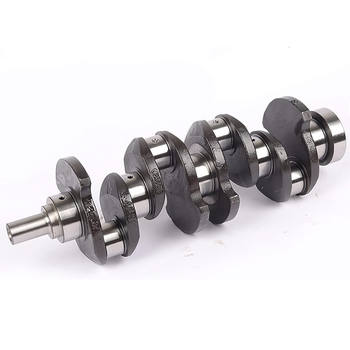
The crankshaft, the backbone of any engine, transforms the reciprocating motion of pistons into rotational power. But what makes one crankshaft stronger than another? This is a crucial question for anyone building a high-performance engine, where the crankshaft must endure extreme stress and strain. Understanding the factors that contribute to crankshaft strength is paramount to achieving reliable and powerful performance. So, what is the strongest crankshaft, and what should you look for?
Crankshaft Materials: The Foundation of Strength
The material a crankshaft is made from plays a critical role in its overall strength. Common materials include cast iron, forged steel, and billet steel. Cast iron, while cost-effective, is the weakest option, suitable primarily for stock engines. Forged steel, a step up in strength, is created by hammering a heated steel billet into shape, refining the grain structure and increasing its toughness. Billet steel represents the pinnacle of crankshaft material, offering the highest strength-to-weight ratio. Machined from a solid block of steel, billet crankshafts offer unparalleled strength and are the preferred choice for high-performance applications.
Manufacturing Processes: Shaping Strength and Durability
Beyond the base material, the manufacturing process heavily influences a crankshaft's resilience. Forging, as mentioned earlier, improves the grain flow of the steel, making it stronger and more resistant to fatigue. Billet crankshafts benefit from precise machining, allowing for optimized designs and tighter tolerances. Furthermore, specialized heat treatments and surface hardening processes, such as nitriding, can further enhance the strength and wear resistance of the crankshaft.
Crankshaft Design: Optimizing for Performance and Reliability
The design of the crankshaft itself plays a vital role in its overall strength. Factors like the journal diameter, crankpin size, and counterweight configuration all contribute to the crankshaft's ability to withstand stress. A larger journal diameter, for example, provides a larger bearing surface area, distributing loads more effectively. Similarly, optimized counterweights help balance the rotating assembly and reduce vibrations, which can contribute to fatigue failure. What specific design features should you be looking for in a high-performance crankshaft? This depends heavily on the application and the expected power output.
Billet vs. Forged: The Strength Showdown
The debate between billet and forged crankshafts often comes up when discussing ultimate strength. While both offer significant advantages over cast crankshafts, billet steel generally takes the crown. The precise machining and inherent material properties of billet steel allow for stronger, lighter crankshafts that can handle extreme horsepower levels. However, forged crankshafts, especially those made from high-quality steel and subjected to proper heat treatment, can still offer exceptional strength and are often a more cost-effective option for moderately modified engines. The "strongest crankshaft" often comes down to the specific application and budget.
Beyond Material and Manufacturing: Other Factors Affecting Strength
While material and manufacturing processes are primary factors, other elements influence crankshaft strength. Proper lubrication is crucial to prevent wear and tear on the bearings and journals. Maintaining correct engine operating temperatures also helps to ensure optimal crankshaft performance and longevity. Finally, proper installation and balancing are essential for preventing vibrations and premature failure.
Choosing the Right Crankshaft for Your Application
So, what is the strongest crankshaft for *your* needs? The answer depends on your specific application and performance goals. For a high-performance engine pushing significant horsepower, a billet crankshaft is often the ideal choice. For a moderately modified engine, a high-quality forged crankshaft can provide ample strength and reliability. Considering factors like your engine's displacement, expected power output, and budget will help you determine the most appropriate crankshaft for your build.
Long-Term Crankshaft Care and Maintenance
Choosing the strongest crankshaft is just the first step. Proper maintenance is crucial for ensuring its long-term durability and performance. Regular oil changes with high-quality lubricants, maintaining correct engine operating temperatures, and periodic inspections are all essential for maximizing the lifespan of your crankshaft.
Pushing the Limits: Extreme Performance Crankshafts
For those seeking the absolute limits of performance, specialized crankshafts are available. These often feature exotic materials, advanced manufacturing techniques, and highly optimized designs to withstand extreme horsepower and RPM. However, these high-performance crankshafts often come with a premium price tag.
Final Thoughts: Investing in a Strong Foundation
The crankshaft is the heart of your engine, and choosing the right one is crucial for achieving reliable and powerful performance. While billet steel crankshafts generally offer the highest strength, factors like manufacturing processes, design, and proper maintenance all play a role in overall durability. By understanding these factors, you can make an informed decision and select the strongest crankshaft that meets your specific needs and budget. Investing in a strong crankshaft is an investment in the long-term health and performance of your engine. So, take the time to research and choose wisely. What are your experiences with different crankshaft materials and designs? Share your thoughts in the comments below!

 The Unseen Powerhouse: Unveili
The Unseen Powerhouse: Unveili
 Unveiling the Precision: The A
Unveiling the Precision: The A
 Navigating the World of Cranks
Navigating the World of Cranks
 The Unsung Heroes: What Makes
The Unsung Heroes: What Makes
